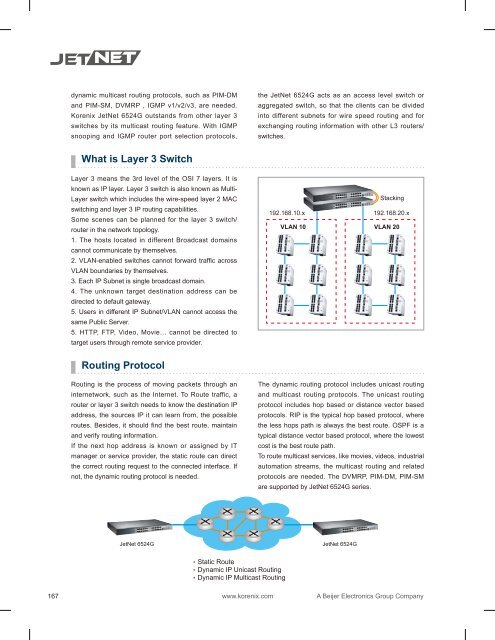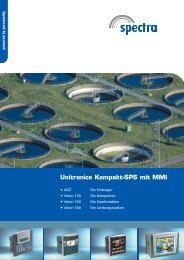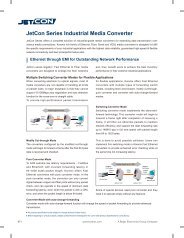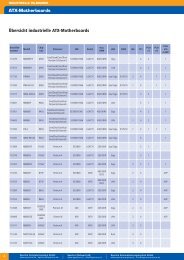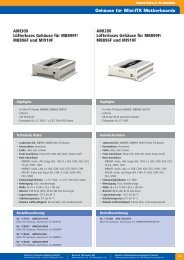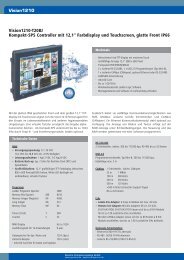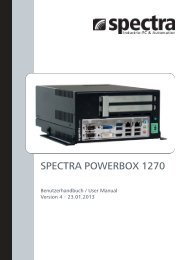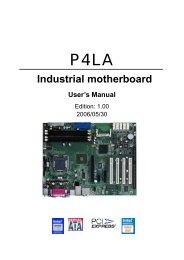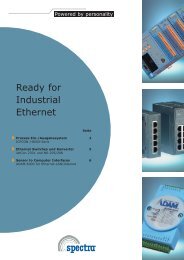JetNet Series Industrial L2 / L3 Rackmount / Rail Ethernet Switch
JetNet Series Industrial L2 / L3 Rackmount / Rail Ethernet Switch
JetNet Series Industrial L2 / L3 Rackmount / Rail Ethernet Switch
You also want an ePaper? Increase the reach of your titles
YUMPU automatically turns print PDFs into web optimized ePapers that Google loves.
dynamic multicast routing protocols, such as PIM-DM<br />
and PIM-SM, DVMRP , IGMP v1/v2/v3, are needed.<br />
Korenix <strong>JetNet</strong> 6524G outstands from other layer 3<br />
switches by its multicast routing feature. With IGMP<br />
snooping and IGMP router port selection protocols,<br />
the <strong>JetNet</strong> 6524G acts as an access level switch or<br />
aggregated switch, so that the clients can be divided<br />
into different subnets for wire speed routing and for<br />
exchanging routing information with other <strong>L3</strong> routers/<br />
switches.<br />
What is Layer 3 <strong>Switch</strong><br />
Layer 3 means the 3rd level of the OSI 7 layers. It is<br />
known as IP layer. Layer 3 switch is also known as Multi-<br />
Layer switch which includes the wire-speed layer 2 MAC<br />
switching and layer 3 IP routing capabilities.<br />
Some scenes can be planned for the layer 3 switch/<br />
router in the network topology.<br />
1. The hosts located in different Broadcast domains<br />
cannot communicate by themselves.<br />
2. VLAN-enabled switches cannot forward traffic across<br />
VLAN boundaries by themselves.<br />
3. Each IP Subnet is single broadcast domain.<br />
4. The unknown target destination address can be<br />
directed to default gateway.<br />
5. Users in different IP Subnet/VLAN cannot access the<br />
same Public Server.<br />
5. HTTP, FTP, Video, Movie… cannot be directed to<br />
target users through remote service provider.<br />
192.168.10.x<br />
VLAN 10<br />
Stacking<br />
192.168.20.x<br />
VLAN 20<br />
Routing Protocol<br />
Routing is the process of moving packets through an<br />
internetwork, such as the Internet. To Route traffic, a<br />
router or layer 3 switch needs to know the destination IP<br />
address, the sources IP it can learn from, the possible<br />
routes. Besides, it should find the best route, maintain<br />
and verify routing information.<br />
If the next hop address is known or assigned by IT<br />
manager or service provider, the static route can direct<br />
the correct routing request to the connected interface. If<br />
not, the dynamic routing protocol is needed.<br />
The dynamic routing protocol includes unicast routing<br />
and multicast routing protocols. The unicast routing<br />
protocol includes hop based or distance vector based<br />
protocols. RIP is the typical hop based protocol, where<br />
the less hops path is always the best route. OSPF is a<br />
typical distance vector based protocol, where the lowest<br />
cost is the best route path.<br />
To route multicast services, like movies, videos, industrial<br />
automation streams, the multicast routing and related<br />
protocols are needed. The DVMRP, PIM-DM, PIM-SM<br />
are supported by <strong>JetNet</strong> 6524G series.<br />
<strong>JetNet</strong> 6524G<br />
<strong>JetNet</strong> 6524G<br />
Static Route<br />
Dynamic IP Unicast Routing<br />
Dynamic IP Multicast Routing<br />
167 www.korenix.com<br />
A Beijer Electronics Group Company


